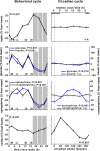Adverse metabolic and cardiovascular consequences of circadian misalignment
- PMID: 19255424
- PMCID: PMC2657421
- DOI: 10.1073/pnas.0808180106
Adverse metabolic and cardiovascular consequences of circadian misalignment
Abstract
There is considerable epidemiological evidence that shift work is associated with increased risk for obesity, diabetes, and cardiovascular disease, perhaps the result of physiologic maladaptation to chronically sleeping and eating at abnormal circadian times. To begin to understand underlying mechanisms, we determined the effects of such misalignment between behavioral cycles (fasting/feeding and sleep/wake cycles) and endogenous circadian cycles on metabolic, autonomic, and endocrine predictors of obesity, diabetes, and cardiovascular risk. Ten adults (5 female) underwent a 10-day laboratory protocol, wherein subjects ate and slept at all phases of the circadian cycle-achieved by scheduling a recurring 28-h "day." Subjects ate 4 isocaloric meals each 28-h "day." For 8 days, plasma leptin, insulin, glucose, and cortisol were measured hourly, urinary catecholamines 2 hourly (totaling approximately 1,000 assays/subject), and blood pressure, heart rate, cardiac vagal modulation, oxygen consumption, respiratory exchange ratio, and polysomnographic sleep daily. Core body temperature was recorded continuously for 10 days to assess circadian phase. Circadian misalignment, when subjects ate and slept approximately 12 h out of phase from their habitual times, systematically decreased leptin (-17%, P < 0.001), increased glucose (+6%, P < 0.001) despite increased insulin (+22%, P = 0.006), completely reversed the daily cortisol rhythm (P < 0.001), increased mean arterial pressure (+3%, P = 0.001), and reduced sleep efficiency (-20%, P < 0.002). Notably, circadian misalignment caused 3 of 8 subjects (with sufficient available data) to exhibit postprandial glucose responses in the range typical of a prediabetic state. These findings demonstrate the adverse cardiometabolic implications of circadian misalignment, as occurs acutely with jet lag and chronically with shift work.
Conflict of interest statement
The authors declare no conflict of interest.
Figures





Comment in
-
Obeying the clock yields benefits for metabolism.Proc Natl Acad Sci U S A. 2009 Mar 17;106(11):4069-70. doi: 10.1073/pnas.0901304106. Epub 2009 Mar 10. Proc Natl Acad Sci U S A. 2009. PMID: 19276118 Free PMC article. Review. No abstract available.
References
-
- U.S. Department of Labor. Workers on Flexible and Shift Schedules in 2004 Summary. Washington, D.C.: Bureau of Labor Statistics; 2005.
-
- Knutsson A, Åkerstedt T, Jonsson BG, Orth-Gomer K. Increased risk of ischaemic heart disease in shift workers. Lancet. 1986;12:89–91. - PubMed
-
- Kroenke CH, et al. Work characteristics and incidence of type 2 diabetes in women. Am J Epidemiol. 2007;165:175–183. - PubMed
Publication types
MeSH terms
Grants and funding
LinkOut - more resources
Full Text Sources
Other Literature Sources
Medical
Research Materials

